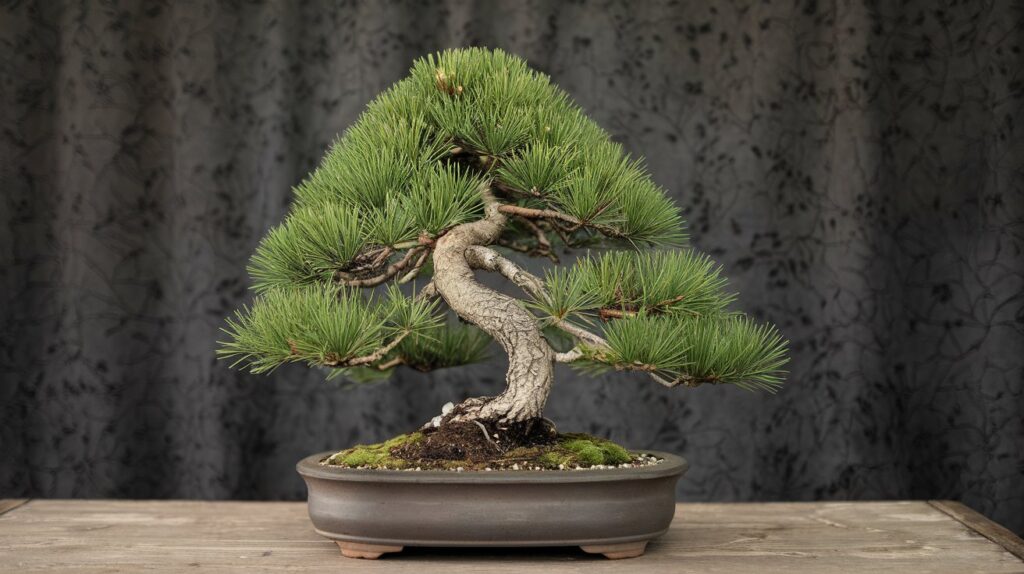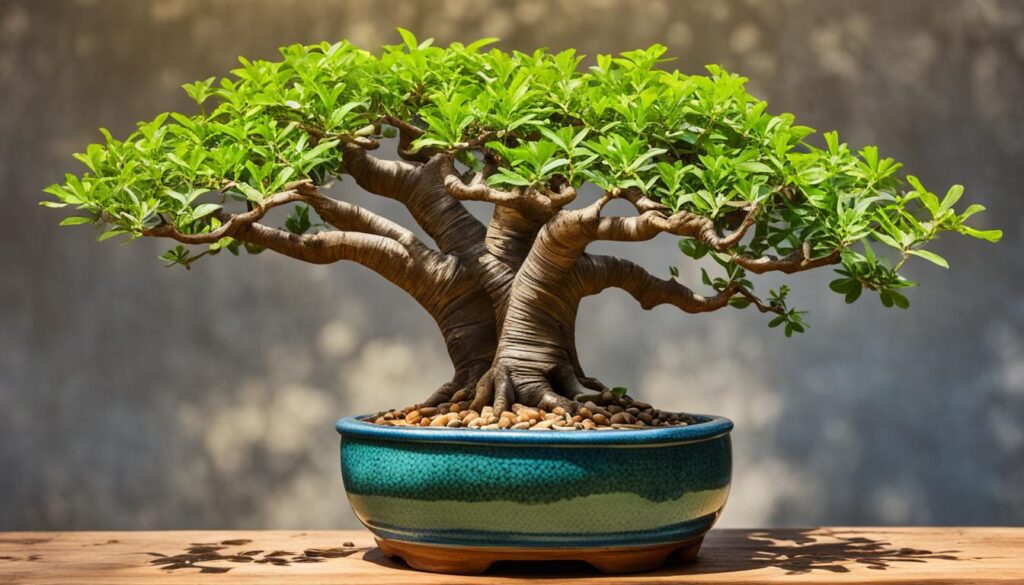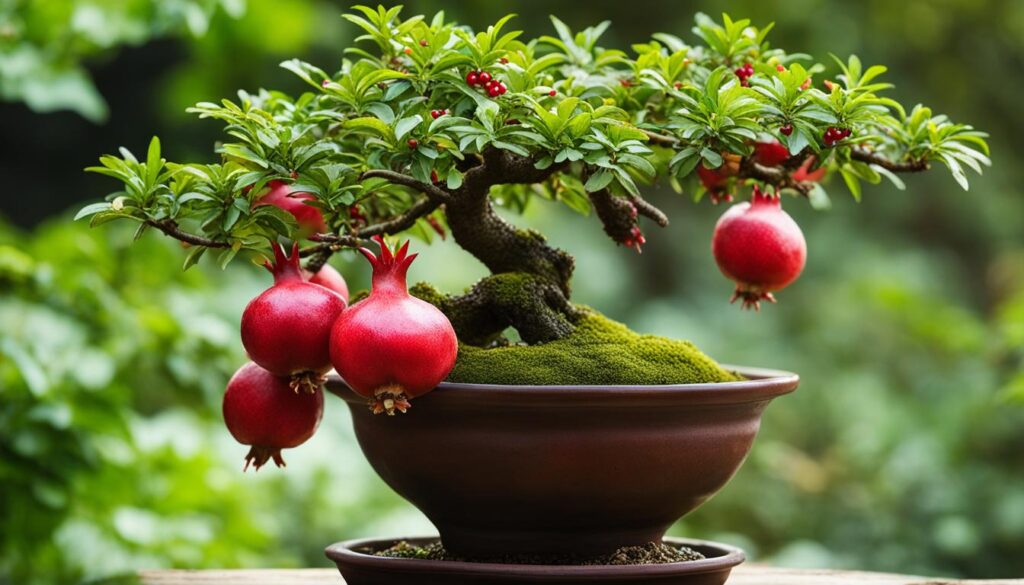The White Pine bonsai tree, known for its elegance and serene beauty, is a cherished species in the art of bonsai. Originating from Japan, this tree, often referred to as the Japanese White Pine (Pinus parviflora), is renowned for its delicate needles and graceful, twisted trunk that embodies the essence of nature in miniature form.
Key Takeaways
ToggleJapanese White Pine Bonsai Tree: A Distinct Species

Needle Arrangement: The Japanese White Pine has five needles per bundle, whereas other species, like the Black Pine (Pinus thunbergii), typically have two. This gives it a denser and more refined appearance.
Needle Color: Its needles have a distinctive bluish-white hue, creating a silvery appearance, unlike the darker green needles of many other pine species.
Growth Rate: The Japanese White Pine grows more slowly compared to species like the Red Pine (Pinus densiflora) or Black Pine, making it ideal for bonsai enthusiasts who value detailed, long-term cultivation.
Bark Texture: The bark of the Japanese White Pine is smoother and less rugged, even as the tree ages, whereas other species, such as Black Pines, develop a coarser, more textured bark over time.
Is White Pine Good for Bonsai
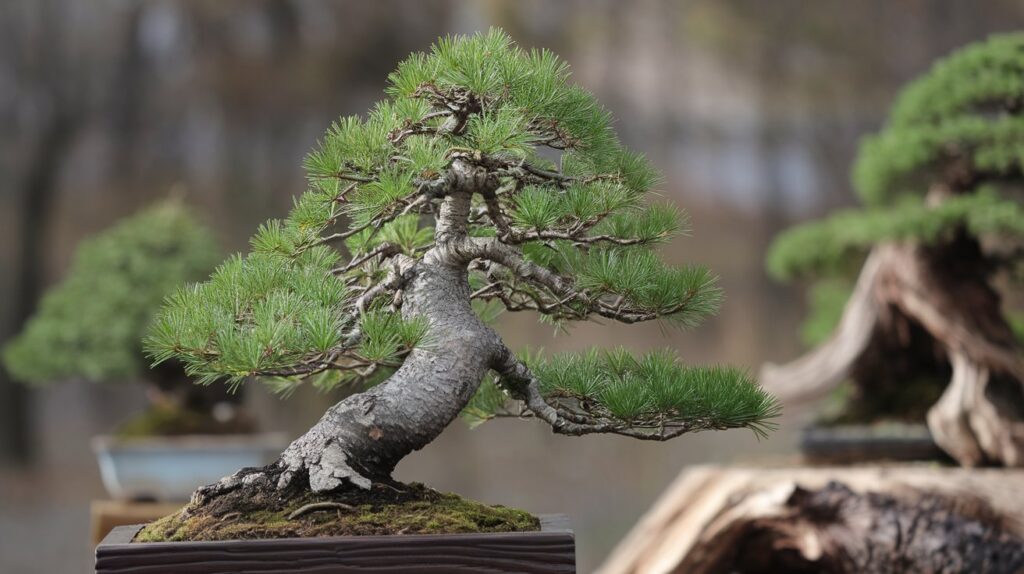
The Japanese white pine (Pinus parviflora) is a top choice for bonsai due to its hardiness and visual appeal.
Suitability for Bonsai
Hardiness: The Japanese white pine thrives in various conditions, tolerates frost, and endures extreme temperatures, making it ideal for outdoor bonsai.
Aesthetic Qualities: Its soft, bluish-green needles and upright growth enhance bonsai arrangements, while its smooth gray bark adds ornamental value.
Growth Characteristics: Slow growth requires less frequent pruning, and its flexible branches allow for creative shaping, suiting various bonsai styles.
Pest Resistance: This species is relatively pest-resistant, making maintenance easier.
Watering and Light Needs: It requires soil to dry between waterings and thrives in full sunlight, promoting compact needle growth for an appealing bonsai aesthetic.
How to Grow a White Pine Bonsai
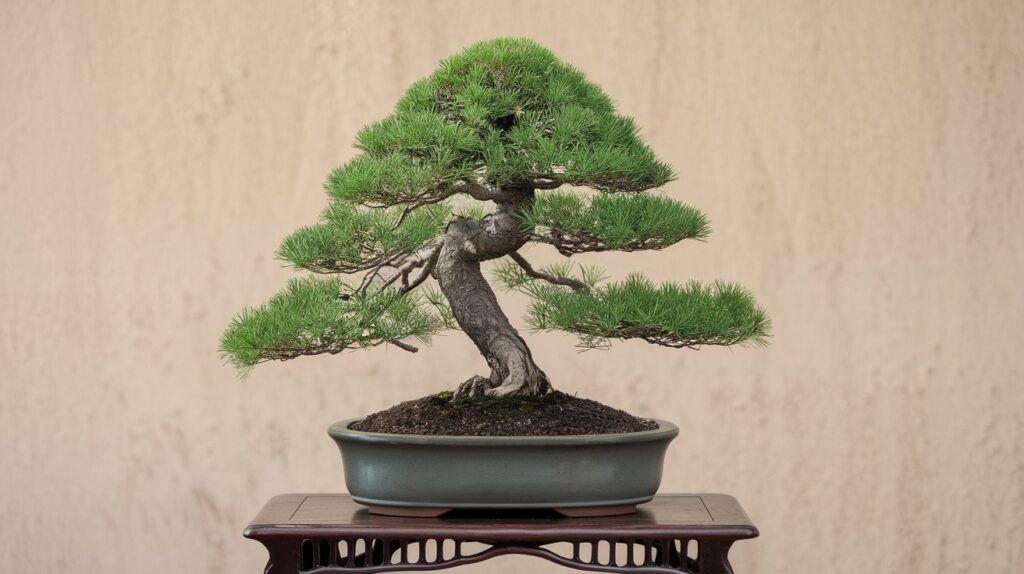
Growing a Japanese white pine bonsai (Pinus parviflora) requires specific care and attention. Here’s a concise guide to help you cultivate a healthy bonsai.
Step-by-Step Guide to Growing a White Pine Bonsai
Selecting the Tree
Choose a healthy Japanese white pine sapling with a straight trunk and strong roots.Preparing the Soil
Use a well-draining soil mix:
- 50% akadama
- 25% pumice
- 25% lava rock
This mix prevents waterlogging and ensures adequate oxygen for the roots.
- Potting the Bonsai
Select a shallow bonsai pot with drainage holes.
- Cover the holes with a mesh screen to retain soil.
- Add coarse soil for drainage, then the prepared soil mix.
- Position the tree and fill around the roots, avoiding air pockets.
- Watering
Water thoroughly after potting.
- Allow the top inch of soil to dry before watering again.
- Keep the soil moist but not soggy during the growing season.
- In winter, reduce watering and protect from freezing temperatures.
- Light and Location
Place the bonsai outdoors in a bright, sunny spot.
- It thrives in full sun but can tolerate some shade.
- Avoid too much shade to prevent elongated needles.
- Fertilizing
Fertilize from early spring to late fall with a balanced bonsai fertilizer.
- Avoid nitrogen-rich fertilizers to prevent excessive top growth.
- Use slow-release or diluted liquid fertilizer every few weeks.
- Pruning and Styling
- Prune in early spring and late summer. Pinch back new growth by about one-third.
- Wire branches to shape the bonsai, removing the wire before it cuts into the bark.
- Monitoring Health
Watch for signs of pests or diseases, such as needle drop or discoloration, which may indicate watering issues or poor soil quality.
How to Care for a Japanese White Pine Bonsai
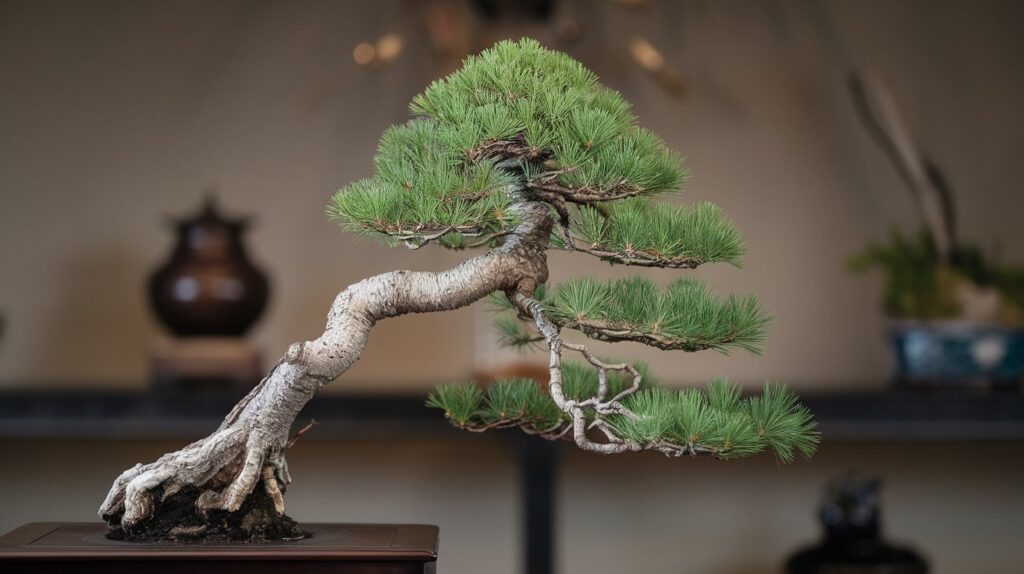
Caring for a Japanese white pine bonsai (Pinus parviflora) requires attention to its watering, sunlight, and pest management needs. Here are essential tips to keep your bonsai healthy.
Watering Techniques
- Frequency: Water thoroughly when the top inch of soil is dry, ensuring the roots are saturated. Allow excess water to drain.
- Overwatering Signs: Yellowing needles and a mushy root system indicate overwatering and potential root rot.
- Winter Care: Reduce watering in winter but keep the soil slightly moist to prevent dehydration.
Ideal Sunlight Conditions
- Sun Exposure: Place the bonsai in full sunlight for several hours daily to promote compact needle growth. Insufficient light leads to elongated needles.
- Temperature Tolerance: The bonsai can handle a wide temperature range, thriving in full sun but needing protection from extreme heat (over 100°F). It can withstand cold down to 20°F, making it suitable for year-round outdoor cultivation.
Pest Management
- Common Pests: Watch for aphids, spider mites, and scale insects, though white pines are generally pest-resistant.
- Preventive Measures: Ensure good air circulation and avoid overcrowding. If pests are detected, treat with insecticidal soap or neem oil.
Additional Care Tips
- Fertilization: Use a balanced fertilizer from early spring to late fall, avoiding high-nitrogen formulas to prevent excessive top growth.
- Pruning: Prune in early spring and late summer to maintain shape and encourage bushier growth. Pinch back new growth (candles) to promote branching and a compact form.
Pruning and Styling Techniques for White Pine Bonsai
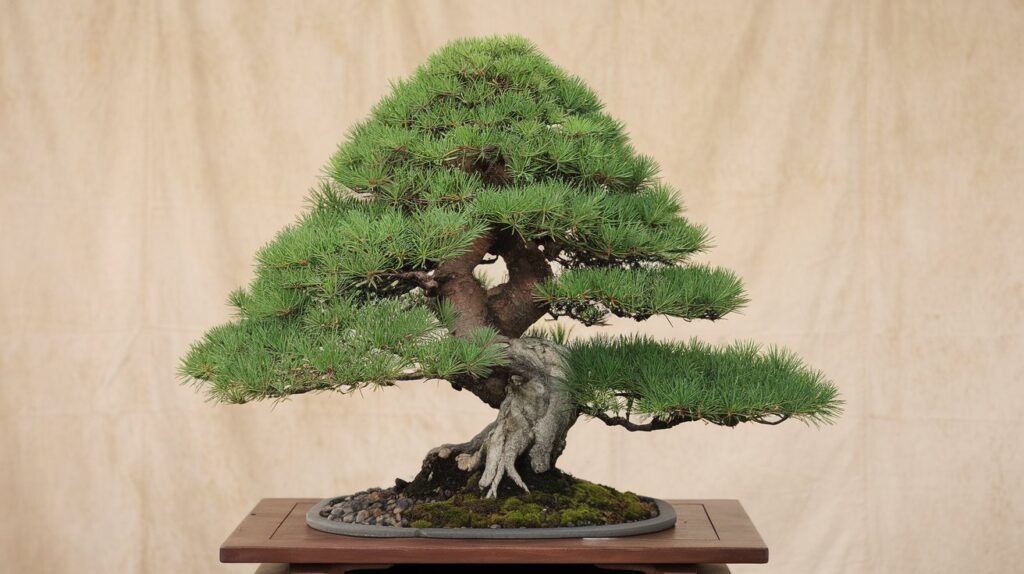
Pruning and styling are crucial for maintaining the shape and health of a white pine bonsai tree (Pinus parviflora). These techniques enhance the tree’s appearance and promote healthy growth. Here’s how to effectively prune and style your white pine bonsai:
Pruning Techniques
Candle Pruning: Trim new growth, called “candles,” in late spring or early summer when they have elongated but not yet hardened. Use sharp, sterilized shears to cut at the base, trimming stronger candles more significantly to encourage balanced growth.
Pinching: Pinch off the tips of new shoots during the growing season to encourage branching and compact growth.
Seasonal Pruning:
- Spring: Prune after new growth hardens to refine the shape and remove unwanted growth.
- Fall: Prune in early fall to prepare the tree for winter, aiding recovery and energy storage for the next growing season.
Styling Techniques
Wiring: Wire branches during the dormant season or after candle pruning to shape them. Use thin wire and avoid wiring too tightly to prevent bark damage. White pine branches are flexible and allow for extended wiring periods due to slow growth.
Encouraging Compact Growth: Regular pruning and proper watering are essential. Water thoroughly but let the soil dry between waterings to maintain root health and encourage compact growth. Provide full sunlight for several hours daily to develop short, compact needles.
Maintenance Tips
Post-Pruning Care: Ensure the tree gets enough water, sunlight, and fertilization after pruning to support recovery and new growth.
Monitoring Health: Regularly check for pests and diseases to ensure the tree remains healthy and can recover from pruning.
Fertilizing and Soil Requirements
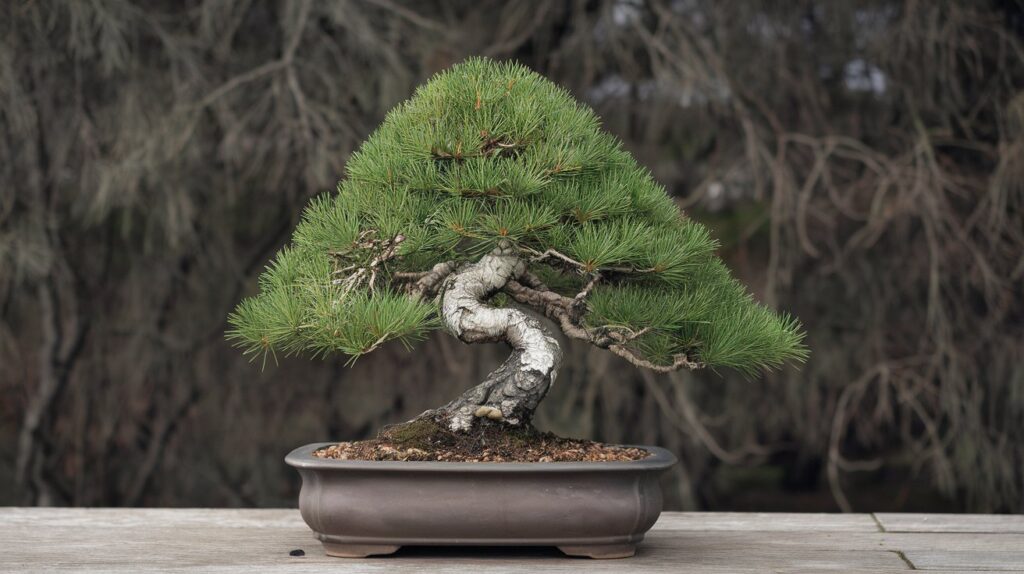
Fertilization Schedule
- Growing Season (March to September): Fertilize regularly to support growth.
- Frequency: Apply solid organic fertilizers like Biogold or Hanagokoro every 4 to 6 weeks, or use liquid fertilizers at lower concentrations more frequently. For older trees, use lower concentrations but fertilize more often.
Types of Fertilizers
- Organic Fertilizers: Choose balanced organic options that release nutrients slowly and avoid high nitrogen levels to prevent weak growth.
- Slow-Release Fertilizers: Apply products like Naruko Slow Release Bonsai Feed every 1 to 2 months for steady nutrient supply.
Application Tips
- Incorporate solid fertilizers into the soil surface. For liquid fertilizers, dilute to half strength for older trees. Adjust fertilization based on the tree’s response.
Soil Requirements
- Well-Draining Mix: Use a mix of akadama, pumice, and lava rock in equal parts to ensure proper moisture retention and aeration.
- Repotting: Repot every 2 to 5 years in early spring, leaving some old soil to preserve beneficial microorganisms.
Watering Considerations
- Allow the soil to dry slightly between waterings. Water thoroughly when the top inch of soil is dry, ensuring the entire root system is hydrated.
Seasonal Care: Winter Protection for Your Bonsai
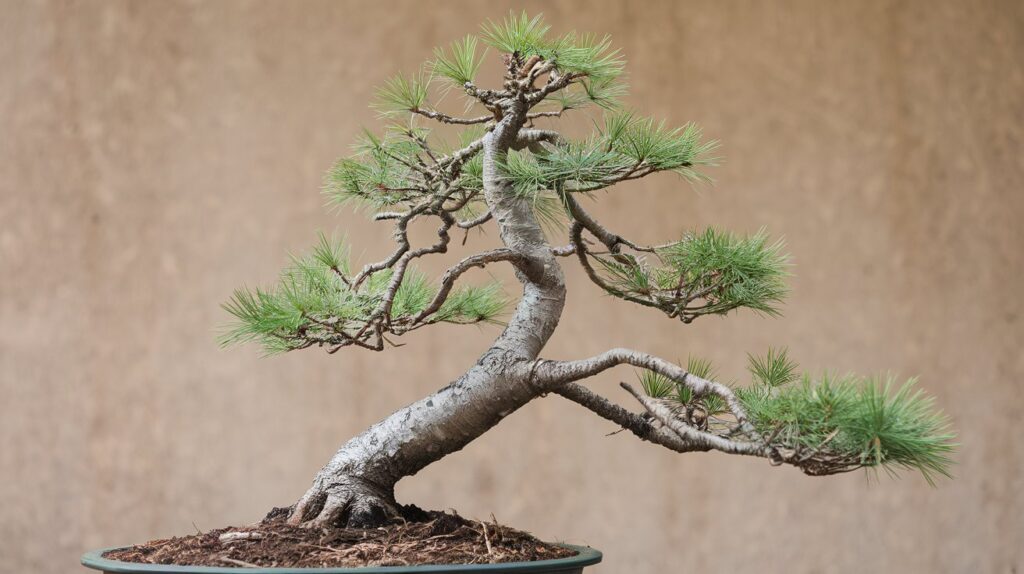
Protecting your Japanese white pine bonsai (Pinus parviflora) during winter is essential for its survival and health. Follow these tips to keep your bonsai thriving.
Location:
- Outdoor Placement: Japanese white pines are hardy and can tolerate cold temperatures, often surviving below freezing. Keep them outdoors in a sheltered, sunlit location.
- Avoiding Frost Damage: Protect your bonsai from extreme conditions by placing it in a cold frame or unheated greenhouse. This shields it from harsh winds and freezing temperatures while allowing ventilation and preventing soil from freezing solid.
Soil and Watering:
- Well-Draining Soil: Use well-draining soil, such as a mix of akadama, pumice, and lava rock, to prevent waterlogging.
- Watering Considerations: Monitor moisture levels carefully. Water when the top inch of soil is dry, but avoid overwatering. If the soil freezes, roots cannot absorb water, leading to damage.
Mulching:
- Insulating the Roots: Apply a layer of mulch, like pine needles or shredded bark, around the base to insulate the roots and maintain stable soil temperature.
Monitoring Temperature:
- Temperature Awareness: White pines can tolerate temperatures down to -10°C (14°F) when protected. If temperatures drop lower, move the bonsai to a more sheltered location.
- Sunlight Exposure: Ensure the bonsai receives adequate sunlight during winter for photosynthesis, even during dormancy.
Avoiding Indoor Placement:
- Outdoor Dormancy: Avoid bringing your bonsai indoors, as this disrupts its natural dormancy cycle. If necessary, place it in an unheated room with sufficient light.
Regular Checks:
- Inspecting Health: Regularly check for signs of stress, such as needle drop or discoloration, and address issues promptly to prevent damage.
Conclusion
In conclusion, the White Pine bonsai tree is a captivating choice for both novice and experienced bonsai enthusiasts. With its striking appearance and adaptability, this species offers a unique opportunity to engage in the art of bonsai while fostering a deeper connection to nature. By understanding its specific care requirements—such as proper watering, pruning, and seasonal protection—you can cultivate a healthy and beautiful bonsai that flourishes over time. Embracing the journey of growing a White Pine bonsai not only enhances your gardening skills but also instills a sense of tranquility and accomplishment, making it a rewarding addition to any bonsai collection.

